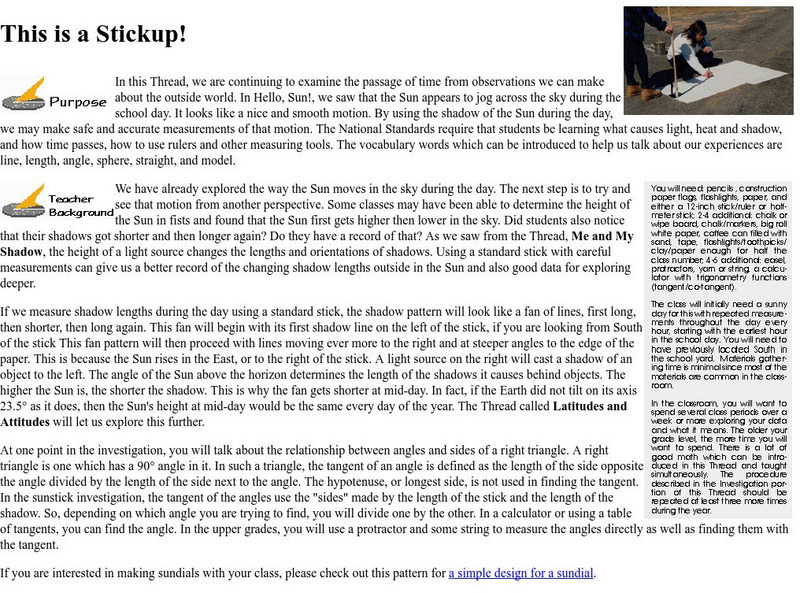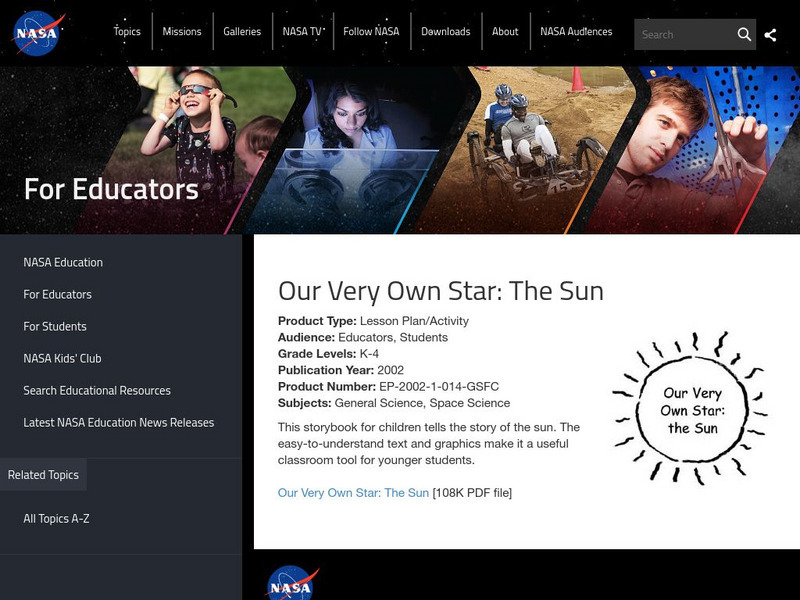Hi, what do you want to do?
Other
The Apollo Society: The Solar System
Contains a small set of images of solar system objects and a series of links to information about all solar system objects. Solar System Tours link to excellent image collections.
Harvard University
University of Harvard: This Is a Stickup!
Students are taught how to make a sundial. The relationship between angles and the sides of a right triangle are explored. Great lesson plan ideas with plenty of background information. The lesson is adapted for grade levels k-6 with...
Harvard University
Harvard University: The Sun
Includes a brief history of the sun's development and its future. Also provides simple statistics, solar activities, and references.
Atomic Archive
Atomic Archive: Nuclear Fusion
From the Atomic Archive - the online companion to the award-winning CD-ROM. This page defines nuclear fusion and depicts the process by an informative diagram. Includes numerical values which describe the typical energy values for fusion...
NASA
Nasa: Eclipses
The periodicity and recurrance of eclipses is governed by the Saros cycle, a period of approximately 6,585.3 days (18 years 11 days 8 hours). It was known to the Chaldeans as a period when lunar eclipses seem to repeat themselves, but...
Other
University of Leicester: Sun
Provides a brief overview of the Sun, including a focus on solar eclipses, solar wind, and solar sailing.
US Energy Information Administration
U.s. Eia: Energy Kids: Renewable Energy: Solar
This is a resource on solar energy, photovoltaic energy, solar thermal heat, solar thermal power plants and other forms of energy.
E-learning for Kids
E Learning for Kids: Mediterranean Sea: What Sort of Energy Is Provided by the Sun?
Lorani is a mermaid who lives underwater in the ocean. What she loves most in the world is the sun. Join her and learn about the sun, too.
NASA
Nasa Science: For Kids: Solar System Fun
Test your knowledge about the solar system with games and activities designed to help explore what you know about the sun, the planets and their moons, space rocks, the Milky Way, and related topics.
Read Works
Read Works: From Morning to Night
[Free Registration/Login Required] An informational text about how the day moves from morning to night. A question sheet is available to help students build skills in reading comprehension.
Read Works
Read Works: Sunlight in the Night
[Free Registration/Login Required] An informational text about moonlight and where it comes from. A question sheet is available to help students build skills in reading comprehension.
Read Works
Read Works: Article a Day Set: Time: Parts of a Day
[Free Registration/Login Required] ReadWorks provides numerous resources filled with informational articles. "Parts of a Day" provides information about the parts of a day: morning, afternoon, evening, and night. This passage is designed...
Views of the Solar System
Views of the Solar System: Sun
Explore the sun through this site that includes vivid multimedia resources. Learn sun statistics and view numerous images of the sun and eclipses.
National Museums Liverpool
Liverpool Museums: The Sun Tracker
This simulation allows the user to see the sun's arc in the sky anywhere in the world at any time. By changing the season settings the user can see how seasons affect the height of the sun's arc.
The Wonder of Science
The Wonder of Science: 1 Ess1 1: Sun, Moon, and Star Patterns
The NSTA vetted source includes resources to help students describe patterns of the sun, moon, and stars using observation. Included are assessment ideas, videos, examples, lesson plans, and photos of student work.
The Wonder of Science
The Wonder of Science: 5 Ess1 1: Stellar Brightness and Distance
Students will learn about stellar brightness and distance to be able to support their argument about the apparent brightness of our sun compared to other stars due to their distances with these lesson plans.
Lerner Publishing Group
Lerner Classroom: Teaching Science Through Literacy
In this lesson plan, students will gather evidence to support the argument that differences in the apparent brightness of the sun compared with other stars is due to their relative distances from Earth. Students will also write texts in...
NC State University
Ncsu.edu: Adventures of the Agronauts
This site is an online science curriculum on how to grow plants on the Moon. There are six lessons that have a glossary also included. There are movies that demonstrate concepts, and teacher resources. The sites topics cover, the Earth,...
NC State University
Adventures of the Agronauts
Come along with the Agronauts and discover space in order to report back to Commander Spud Goodroot. Fun site provides all types of information about space science! Various missions include: 'What's In Our Sky?', 'The Root of the...
Project Britain
Primary Homework Help: Earth and Space Quiz
This resource provides information about Earth and space. In addition, there is a quiz provided.
NASA
Nasa: Classroom Activity: Our Very Own Star: The Sun
This PDF storybook for children tells the story of the sun. The easy-to-understand text and graphics make it a useful classroom tool for younger students.
PBS
Pbs Learning Media: What Causes the Gulf Stream?
This video segment adapted from NOVA uses satellite imagery to illustrate the Gulf Stream's path and animations to explain how atmospheric phenomena cause it to move. [1:51]
Next.cc
Next: Solar Energy
Engage in the activities provided to learn how you can use the sun as a source of energy. Click on the links for further exploration.





















